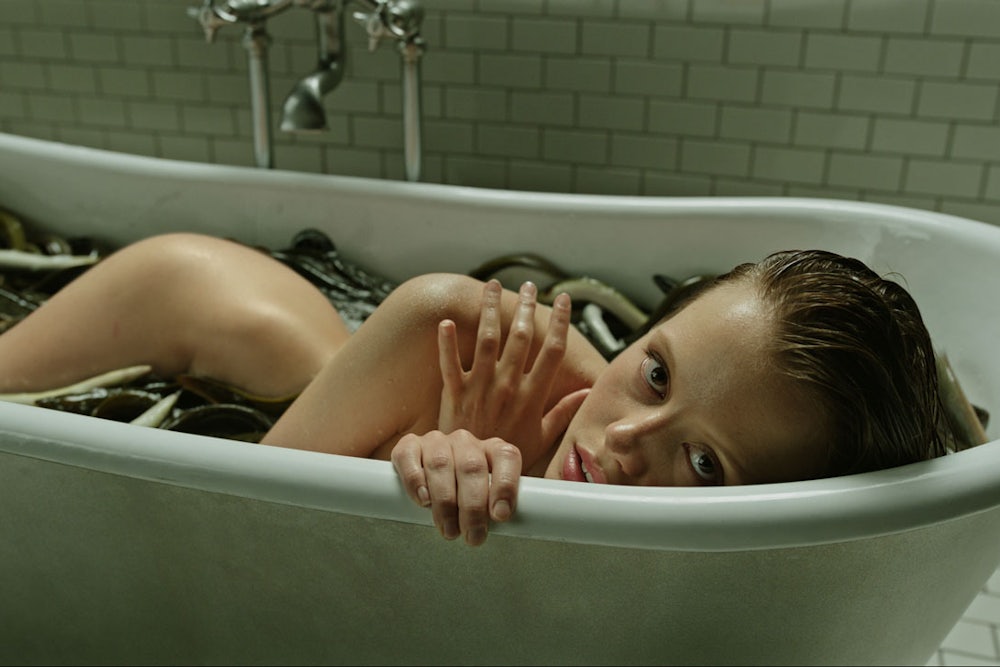Sigmund Freud hated bicycles. He also hated motorcycles, which is more intuitive since they are noisy and dangerous. But what is there to hate about bicycles? I thought a lot about Freud and the mysteries of the human subconscious while watching A Cure for Wellness, the new horror movie from director Gore Verbinski. As the hero and heroine try to escape on a bike from a horrible mountaintop sanatorium full of nasty repressed desires, you can almost hear Freud shaking his fist.
A Cure for Wellness tells the story of a young jerk (Lockhart, played by the icy Dane Haan) in financial services who tries to retrieve a missing board member from the sanatorium, located in the Swiss Alps. From the start something icky is afoot. Everything is blue and wet. The city sky is blue-grey and rainy. Computers glow blue. A man has a heart attack clutching a blue plastic cup by a blue plastic water cooler. Lockhart’s blue eyes narrow as he scoops up a dead office goldfish and throws it into the trash. Grindingly creepy music fills out the David Fincher-esque flavor of these early scenes. Swan Lake-like melodies dance on top of dark bass lines.
Once Lockhart makes it to Switzerland, his unease grows. The board member does not wish to be rescued, and the sanatorium’s director Volmer (Jason Isaacs) does not wish for Lockhart to leave either. That decision is made for them both after Lockhart breaks a leg in a mountain car crash caused by a very sublime and enormous stag. As in Thomas Mann’s The Magic Mountain, the hero becomes the patient.
At the sanatorium Lockhart meets a “special case” named Hannah—played by Mia Goth, the all-time most goth name. But as Lockhart’s treatments progress the lid starts to come off this creepy place, where the nurses wear starched uniforms and everybody just gives off the air of Nazism. Specifically, the issue is eels. There are eels in places you do not expect them.
The reason for the eels is pretty complicated, and to discover the secret of their origin Lockhart enlists the help of the Goth and a guest named Victoria Watkins (the sparkling Celia Imrie). When Lockhart first arrived at the sanatorium two large wrought-iron gates parted: Two intertwined Hippocratic snakes broke apart. They were eels all along, the viewer realizes. The doctor’s oath to do no harm perhaps does not apply when the snakes are actually eels.
Eels are a good horror movie creature. They’re not overdone, like sharks or snakes, but they’re no less wriggly and disgusting. They are the literal “something in the water.” There’s something phallic to their shape, and the eels in this movie seem destined for human orifices. They’re slippery and fishy and serpentine all at once. They get under one’s skin.
But the eels are only one of the Freudian melodies haunting A Cure for Wellness. The movie is rife with complexes, notably around incest. It is no great spoiler to say that the whole sanatorium’s grotesque enterprise is driven by a mysterious phenomenon lurking underneath it: a dark, horrible, underground id.
A Cure for Wellness certainly engages with a lot of traditions. Structurally, the movie combines Henry James’s The Ambassadors with Thomas Mann’s The Magic Mountain with Ford Madox Ford’s The Good Soldier. But this promising premise is sadly betrayed by a series of plot twists that render A Cure for Wellness more like The Phantom of the Opera than anything else.
The poor ending is a great shame. For Verbinski calls upon a great pantheon of stories in order to talk about daddy issues, yes, but more importantly to talk about capitalism. In the movie, two strains of moneymaking compete. Financial services go up against the wellness industry in a fully binaristic duel: city versus mountaintop, suit versus white coat, aggression versus docility.
Both industries exploit those they profit from, and A Cure for Wellness is at its best when showing how contemporary philosophies of “health and wealth” are, at base, all the same old sin. By throwing in some Nazi overtones via blond haircuts and Marathon Man references, Verbinski firmly connects contemporary Californian wellness bullshit to the nastiest of European body-narratives.
What should we make of a movie which is two-thirds good, one-third terrible? When it’s the last third that disappoints, it sticks to the viewer as she walks out the cinema. This particular poor ending felt like a betrayal, since it wrenches A Cure for Wellness fully out of its original genre and into melodrama. The ending hangs like an arm dislocated from its shoulder, its owner already forgetting not to trust the doctors.
